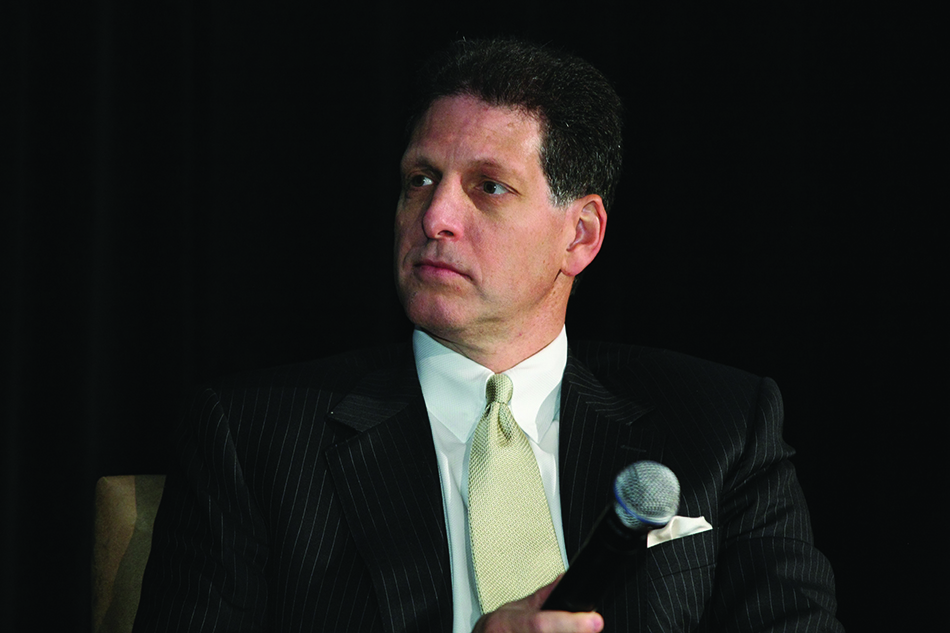Analyst Craig Moffett Punches a Hole in 'Convergence Apocalypse' Theory
MoffettNathanson principal says despite telco fiber builds, paired with wireless, cable still has the broadband advantage

The theory that the recent spike in fiber builds by telcos, coupled with lower prices for 5G and broadband products will pull cable companies into an ever-descending vortex of spending and price-cutting — the so-called Convergence Apocalypse theory — could be one of the reasons for the rapid decline of both telco and cable stocks in the past few months. But in a research note Thursday, MoffettNathanson principal and senior analyst Craig Moffett said that despite the threat of telco fiber overbuilds, cable still has a clear advantage.
Cable stocks have been hit hard as investors have been thrown into a tizzy after two top companies warned of slower than expected broadband subscriber growth in the third quarter. The first tremor was caused by Comcast chief financial officer Mike Cavanagh on Sept. 14, when he told a virtual audience at the Bank of America Media, Communications & Entertainment conference that the cable operator was seeing a “little bit” of a slowdown in broadband subscriber adds in late August. Comcast stock fell more than 7% that day and the rest of the sector — Charter Communications, Altice USA and Cable One — saw their shares dip between 3% and 4%.

The real impact came a few weeks later, when Altice USA CEO Dexter Goei said at the virtual Goldman Sachs Communacopia conference on Sept. 23 that broadband additions would be negative in Q3 — to the tune of 15,000 to 20,000 in subscriber losses — blamed in part on what he said was a sluggish back-to-school period.
Also Read: How Slow Will The Broadband Slowdown Be?
Altice USA stock fell 13% to $22.06 per share on that day, and has had a steady decline ever since, closing at $17.62 each on Oct. 13. Other stocks like Charter Comcast and Cable One also felt the pain, as analysts began to rethink their models to account for what they saw as an accelerated slowdown in growth. At the same time, some analysts were rejiggering their outlooks on telco stocks, especially those that have made commitments to expand their fiber networks like AT&T, Verizon Communications and Frontier Communications.
Also Read: Analyst Says Telcos Better Positioned to Chip Away at Cable’s Broadband Lead
In a research note Thursday, Moffett wrote that both the cable and telecom sectors are getting crushed in the market. Cable distribution stocks are down 16.8% since Sept. 1 and telco stocks like AT&T, T-Mobile, Verizon, Frontier and Lumen Technologies have fallen a collective 10.5%, mainly due to the belief that as telcos build out more fiber and lower prices for broadband, cable subscriber additions will suffer. Conversely, as cable companies drop prices for wireless service, as Comcast did it in August and Charter did earlier this week, that will lead to a long-term slide in telco wireless customers.
The smarter way to stay on top of the multichannel video marketplace. Sign up below.
“In this dystopian converged future, there are no winners,” Moffett wrote. “There is only mutually assured destruction.”
But like any other good conspiracy theory, there is some truth to the thesis — telcos are expanding fiber builds and cable operators are dropping wireless prices — and some not so truthful assumptions. For example, Moffett believes that “Convergence Apocalypse” adherents are forgetting a few key components of the thesis, particularly timing and coverage.
According to Moffett, telcos have targeted an incremental 5 million homes with fiber overbuilds this year, or about 4% of the country. Next year that effort will expand to an additional seven million homes, or 5% of the U.S. By Moffett’s estimates, the percentage of cable plant overbuilt by fiber will grow from 30% currently to about 55% in the next decade.
In this dystopian converged future, there are no winners. There is only mutually assured destruction.
Craig Moffett, MoffettNathanson analyst
“The delays in passing a home, subsequently making the broadband service available for sale, and then actually connecting it, make clear that the competitive impact of this year’s tranche of homes newly passed will only begin to be felt next year, and even then only modestly (we’ve heard arguments that Comcast’s warning of “a little bit of a slowdown” in their Q3 numbers is an early sign of the new fiber overbuilds, but that is not remotely plausible),” Moffett wrote. “And recall that new homes passed in 2020 were the lowest in a decade; it will be at least a few more years before the rolling average of homes passed over the trailing four years or so is meaningfully above average.”
Moffett believes the immediate impact will be on wireless, as cable’s ability to bundle mobile and broadband service at lower prices has the potential to take significant share from the telcos.
Cable can offer broadband throughout its footprint and wireless on a national scale. Telcos are limited in terms of bundling on which parts of the country they offer fiber broadband. For Verizon, that’s about two-thirds of its footprint or 11% of the country and for AT&T, about one-third of its footprint or 13% of the U.S. T-Mobile, Moffett wrote, has no fiber at all.
What has been holding cable wireless back in the past has been pricing, but that changed six months ago when Comcast dropped its family wireless plans to $30 per line per month for four lines or more of unlimited service. Charter introduced its new pricing -- $29.99 per month per line for two or more lines of unlimited service -- and it could be a game changer for the company.
Also Read: Analyst Says It’s Time to Take Cable Wireless Seriously
According to Moffett, both the Comcast and Charter wireless plans are cheaper than those of AT&T, Verizon or T-Mobile, although the traditional telcos offer steep handset discounts the cable companies do not. But that is likely to change.
And then there is the cost.
According to Moffett, telcos are spending up-front, at-risk incremental dollars for their fiber builds, so in order to get return on that investment, they will have to achieve high penetration rates and high average revenue per customer. And while payback periods are typically between six and 10 years, if they fail to hit those targets or costs rise, the periods extend or become unattainable. In contrast, cable wireless is a variable cost business — operators only pay their mobile virtual network operator (MVNO) contract when their customers are using the service. As long as they price the service above that variable cost, they make a profit.
Moffett pointed to a report he did years ago that argued that cable companies had the advantage in the coming convergence climate, a tenet he says holds true today.
Why Wired Nets Hold an Advantage
“The argument was simple: it costs vastly more to put wires under a wireless network than it does to put a wireless network on top of wires,” Moffett wrote. “He who has the best (most ubiquitous) wired network will win. That cable doesn’t even have to bother building out facilities in low-value places — they can let Verizon spend that money on their behalf — only makes their advantage all the more dramatic.”
The analyst added that as the cable industry sees the mobile product as the best way to protect its broadband offerings, they will respond to increasingly aggressive telco fiber buildouts with equally aggressive wireless pricing. That strategy already appears to be working. Moffett estimated that cable is capturing as much as half of all wireless net additions within their broadband customer base even at the old pricing.
Moffett added that the pressure on wireless could force telcos to make a decision — cut their dividend or reduce capital spending. That’s what AT&T was faced with in 2019. It cut capital spending and halted its fiber build in favor of the dividend, then reversed course in 2021, slashing its dividend and recommitting to improving the network.
But in the end, success in the wireless and broadband business is going to come down to price.
“[O]perators will have to pay customers, in the form of a discount, for the disadvantage of forced choice,” Moffett wrote. “Cable’s cost structure and infrastructure advantage allows for them to do that. Verizon’s and AT&T’s do not.”
Mike Farrell is senior content producer, finance for Multichannel News/B+C, covering finance, operations and M&A at cable operators and networks across the industry. He joined Multichannel News in September 1998 and has written about major deals and top players in the business ever since. He also writes the On The Money blog, offering deeper dives into a wide variety of topics including, retransmission consent, regional sports networks,and streaming video. In 2015 he won the Jesse H. Neal Award for Best Profile, an in-depth look at the Syfy Network’s Sharknado franchise and its impact on the industry.

